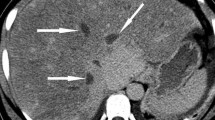Abstract
Objective
To investigate the characteristics and diagnostic value of three-dimensional contrast-enhanced magnetic resonance angiography (3D CE-MRA) in the diagnosis of Budd–Chiari syndrome (BCS).
Methods
One hundred thirty-three BCS patients underwent 3D CE-MRA, 64 patients had primary BCS, and 69 had secondary BCS.
Results
Fifty five cases (41.4%) showed a segmental stenosis of the inferior vena cava, 9 cases (6.8%) a membranous obstruction of the inferior vena cava, 5 cases (3.8%) an unobstructed inferior vena cava and hepatic veno-occlusive condition, 16 cases (12.0%) an inferior vena cava stenosis and hepatic veno-occlusive disease, and 48 cases (36.1%) an intraluminal filling defect in the inferior vena cava. In 52 cases (39.1%), collateral blood vessels were formed, with deep, medium, and shallow portal veins and intrahepatic collateral veins in 88 groups. Among these, 41 (46.6%) had deep venous collateral channels, 24 (27.3%) had medium venous collateral channels, 9 (10.2%) had superficial venous collateral channels, 5 (5.7%) had portal vein collateral channels, and 9 (10.2%) had intrahepatic venous collateral channels.
Conclusion
3D CE-MRA is important in the clinical diagnosis and treatment planning of BCS and displays hepatic veins, the inferior vena cava system, and collateral vessels.









Similar content being viewed by others
References
Hoekstra J, Janssen HL (2008) Vascular liver disorders (I): diagnosis, treatment and prognosis of Budd–Chiari syndrome. Neth J Med 66(8):334–339
Brancatelli G, Vilgrain V, Federle MP, et al. (2007) Budd–Chiari syndrome: spectrum of imaging findings. AJR Am J Roentgenol 188(2):W168–W176
Bayraktar UD, Seren S, Bayraktar Y (2007) Hepatic venous outflow obstruction: three similar syndromes. World J Gastroenterol 13(13):1912–1927
Lupescu IG, Dobromir C, Popa GA, Gheorghe L, Georgescu SA (2008) Spiral computed tomography and magnetic resonance angiography evaluation in Budd–Chiari syndrome. J Gastrointestin Liver Dis 17(2):223–226
Valla DC (2006) Prognosis in Budd Chiari syndrome after re-establishing hepatic venous drainage. Gut 55(6):761–763
Zhang XM, Li QL (2006) Radical surgery under genuine direct vision for the treatment of Budd–Chiari syndrome. Hepatobiliary Pancreat Dis Int 5(1):65–69
Segev DL, Nguyen GC, Locke JE, et al. (2007) Twenty years of liver transplantation for Budd–Chiari syndrome: a national registry analysis. Liver Transpl 13(9):1285–1294
Boeve WJ, Kok T, Haagsma EB, et al. (2001) Superior diagnostic strength of combined contrast enhanced MR-angiography and MR-imaging compared to intra-arterial DSA in liver transplantation candidates. Magn Reson Imaging 19(5):609–622
Lin J, Chen XH, Zhou KR, et al. (2003) Budd–Chiari syndrome: diagnosis with three-dimensional contrast-enhanced magnetic resonance angiography. World J Gastroenterol 9(10):2317–2321
Meng XC, Zhu KS, Qin J, et al. (2007) Clinical significance of multislice spiral CT scans in hepatic veins occlusion in Budd–Chiari syndrome. Chin Med J (Engl) 120(2):100–105
Erden A, Erden I, Karayalcin S, Yurdaydin C (2002) Budd–Chiari syndrome: evaluation with multiphase contrast-enhanced three-dimensional MR angiography. AJR Am J Roentgenol 179(5):1287–1292
Orloff MJ, Daily PO, Orloff SL, Girard B, Orloff MS (2000) A 27-year experience with surgical treatment of Budd–Chiari syndrome. Ann Surg 232(3):340–352
Molmenti EP, Segev DL, Arepally A, et al. (2005) The utility of TIPS in the management of Budd–Chiari syndrome. Ann Surg 241(6):978–981 ((discussion 982–983))
Okuda K (2001) Membranous obstruction of the inferior vena cava (obliterative hepatocavopathy, Okuda). J Gastroenterol Hepatol 16(11):1179–1183
Vignali C, Bargellini I, Grosso M, et al. (2005) TIPS with expanded polytetrafluoroethylene-covered stent: results of an Italian multicenter study. AJR Am J Roentgenol 185(2):472–480
Gandini R, Konda D, Simonetti G (2006) Transjugular intrahepatic portosystemic shunt patency and clinical outcome in patients with Budd–Chiari syndrome: covered versus uncovered stents. Radiology 241(1):298–305
Kamath PS (2006) Budd–Chiari syndrome: radiologic findings. Liver Transpl 12(11 Suppl 2):S21–S22
Feng LS, Peng QP, Li K, et al. (2004) Management of severe Budd–Chiari syndrome: report of 147 cases. Hepatobiliary Pancreat Dis Int 3(4):522–525
Brancatelli G, Federle MP, Grazioli L, Golfieri R, Lencioni R (2002) Large regenerative nodules in Budd–Chiari syndrome and other vascular disorders of the liver: CT and MR imaging findings with clinicopathologic correlation. AJR Am J Roentgenol 178(4):877–883
Mortele KJ, Van Vlierberghe H, Wiesner W, Ros PR (2002) Hepatic veno-occlusive disease: MRI findings. Abdom Imaging 27(5):523–526
Author information
Authors and Affiliations
Corresponding author
Rights and permissions
About this article
Cite this article
Wang, L., Lu, Jp., Wang, F. et al. Diagnosis of Budd–Chiari syndrome: three-dimensional dynamic contrast enhanced magnetic resonance angiography. Abdom Imaging 36, 399–406 (2011). https://doi.org/10.1007/s00261-011-9724-y
Published:
Issue Date:
DOI: https://doi.org/10.1007/s00261-011-9724-y




